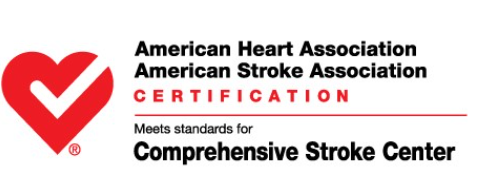Stroke
Mission Hospital's Stroke Center offers a variety of highly effective treatments that can limit damage to the brain and body during a stroke. Our multidisciplinary team of stroke experts works together to ensure the best patient-centered care for your diagnosis, treatment and rehabilitation. Also, we are dedicated to educating the community of western North Carolina to help people live healthier lives and reduce the risk of stroke.
BEFAST - How to Spot a Stroke
- Balance - Is there a sudden loss of balance or coordination?
- Eyes - Is there sudden blurred or double vision or sudden , persistent vision trouble?
- Face - Ask the person to smile. Is one or both sides of the face drooping?
- Arms - Ask the person to raise both arms. Does one side drift downward? Is there weakness or numbness on one side?
- Speech - Does the person have slurred or garbled speech? Can he/she repeat simple phrases?
- Time - Call 911 for immediate medical attention if you notice one or more of these signs. Also, take note of when the symptoms began.

New Ways to Treat Stroke
Mission Hospital's Stroke Center offers a variety of highly effective treatments that can limit damage to the brain and body during a stroke. A subspecialty called Interventional Neuroradiology provides minimally invasive options to treat stroke, brain disorders and other emergencies. Our team is staffed by four physicians fellowship trained in Neurointerventional Surgery and Neuroradiology. Our team works closely with neurosurgery and neurology to evaluate each patient’s needs for treatment. Stroke treatment options include:
- Carotid stenting
- Clot retrieving
- Coiling to treat brain aneurysms
For more information or a referral, call 828-213-1461.

How to Prevent a Stroke
It is estimated that 80 percent of strokes could be prevented. The two leading causes of stroke, atrial fibrillation (AFib – which is a common irregular heart rhythm) and high blood pressure, can both be treated. There are many things you can do to decrease your chance of having a stroke. Some other preventable causes of stroke include diabetes, high cholesterol and circulation problems. If you and your medical team keep these conditions under control, you can help greatly reduce your risk of stroke.
There are some causes of stroke that are not preventable, such as age or family history, but there are many things you can do now to decrease your chance of having a stroke:
- Eat a diet that is rich in fruits and vegetables
- Pick lean meats (if you eat meat)
- Exercise regularly as you are able
- Quit smoking
- Avoid alcohol or drink in moderation
- Know your numbers for your cholesterol, blood pressure and blood sugar – work to keep them in ranges that your medical provider shows you. Download our Know Your Numbers for Stroke infographic
- Take medications as they are prescribed, especially if you have AFib or have had a previous stroke or mini-stroke (as called a TIA)
Remember, if you or someone you love shows signs or symptoms of stroke, BE FAST and help save a life.
Telestroke
The Mission Stroke program has partnered with local hospitals to provide 24-hour access to our acute stroke experts via a 2-way live video and audio consultation and image sharing technology (CT scan). This allows physicians at community hospitals to have immediate access to comprehensive stroke care by simply bringing a mobile technology cart into the patient’s room. A Mission Health stroke expert can simultaneously view electronic patient records while connected to the community hospital in a live video consultation to remotely evaluate the patient and determine the best treatment as fast as possible. Early intervention may reduce the effect of the stroke.
In most cases, EMS will determine based on factors such as symptoms of stroke, time of onset, medications if telestroke or transporting is the best option. If transportation is needed, EMS will transport the stroke patient to the closest stroke treatment capable hospital (local hospital with imaging and tele-stroke capability).
A New Way to Help Rural Stroke Patients
Through this cutting-edge, two-way audio/video conferencing service, we can now connect Mission Hospital’s world-class physicians with remote stroke patients, providing access to the timely, lifesaving measures they need. With the help of our telehealth "robot," our physicians can evaluate these patients in real time and make sure they receive the best diagnosis and treatment.
Telestroke is currently active in the following locations:
- UNC Blue Ridge
- Harris Regional Hospital
- Pardee
- Rutherfordton Regional
- TRH
- AMC
- McDowell
- Highlands-Cashiers Hospital
- Cherokee Indian Hospital
